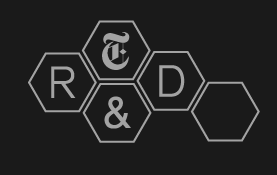 The New York Times Co. took the lid off a new advertising product Thursday with the introduction of Ricochet, which lets companies fuse their brand messages onto sharable NYT Co. content. Using the service, companies can create custom links to New York Times stories they select; the links take readers to a version of the story where the ads on the page are all for the company. It’s a new kind of targeted advertising: Companies select which stories they want to be associated with, then figure out the ways they want to deliver it: tweet, Facebook post, newsletter, or more.
The New York Times Co. took the lid off a new advertising product Thursday with the introduction of Ricochet, which lets companies fuse their brand messages onto sharable NYT Co. content. Using the service, companies can create custom links to New York Times stories they select; the links take readers to a version of the story where the ads on the page are all for the company. It’s a new kind of targeted advertising: Companies select which stories they want to be associated with, then figure out the ways they want to deliver it: tweet, Facebook post, newsletter, or more.
Ricochet will be available on a handful of sites within the Times Company’s stable of properties including NYTimes.com, BostonGlobe.com, Boston.com, and About.com. The first advertiser to use the program is SAP, and you can get a sense of what Ricochet does here (compare it with the same page without the customized link). Pricing for the product will depend on the duration of a campaign and will be sold through the sales staffs at the respective NYT Co. brands.
But beyond an interesting advertising idea, Ricochet is being run out of an interesting new structural idea at NYT HQ. It’s part of a newly formed unit called R&D Ventures, a spin-off from the Times Company’s R&D Lab, a unit we’ve written a lot about. Michael Zimbalist, vice president of research and development operations for the Times Co., told me the new group is a more commercially minded extension of the R&D Lab that focuses on “how to scale and monetize, instead of what does a new user experience look like, or how does content evolve into new spaces.” In other words, the R&D Lab thinks of something new; R&D Ventures works to turn it into a product.
It’s a small group — a handful of people, Zimbalist says — with experience in product development, sales, business development, and other areas. While Ricochet’s been in development since last year, the Ventures group was formed more recently. Zimbalist told me the R&D Lab and R&D Ventures would work almost like a relay team: If an idea from the lab seems like it could find a broader audience (and make money), the baton will be handed off to Team Ventures to bring it to market. “When we contemplate the future of media and marketing, we actually build examples of what we’re thinking about,” Zimbalist said. But the R&D Lab’s work still focuses a bit more on the theoretical — thinking about ideas that might be two years out, not that might be shipped as a new service or feature within months.
That’s basically the story of how Ricochet, and R&D Ventures came to life. Ricochet is rooted in Project Cascade, a time-based visualization of how Times stories move across Twitter. Cascade shows how a story rises and falls, the people who drive pick-up of certain links, the time it takes for a story to come down to earth, all plotted across a graph that makes the social media universe look a bit like an actual universe.
By studying the life of Times stories they discovered something interesting: Companies and consumer brands were tweeting a lot of their work. That’s how they identified the opportunity to transform Cascade into a marketing tool. As part of running Ricochet, companies also get access to a version of Cascade for their own analytics so they can assess their campaigns. With many companies producing content directly for consumers, outlets like the Times can help by providing relevant, authoritative content that doesn’t feel overtly marketing-y, ZImbalist said. “Brands are becoming publishers and developing their own content strategies,” he said.
The story of Ricochet should sound somewhat familiar. Around two years ago, the Times was developing a prototype for social news reader that it eventually moved over to Betaworks. Working in conjunction with ex-Times staff, Betaworks later launched News.me. Zimbalist said they learned from that experience that there are costs and benefits to developing in-house versus outside the company that depend on what’s being built. While ZImbalist wouldn’t discuss any future projects coming out of the R&D Ventures pipeline, he said it’s important that they’re ready to iterate new products when the time comes.
“I think we learned from [News.me] that in order to bring a new product to market, it needed a focused team of entrepreneurially inclined people who were both technically inclined and business inclined,” Zimbalist said.